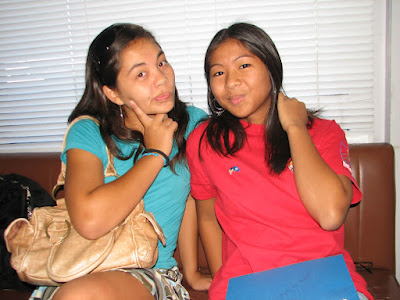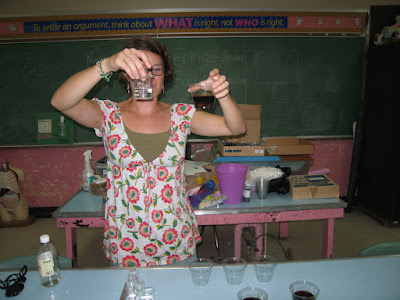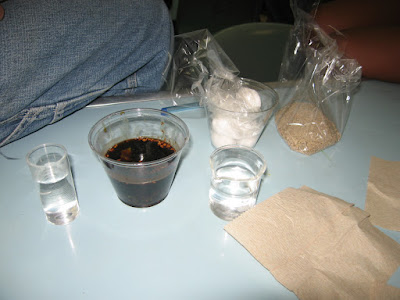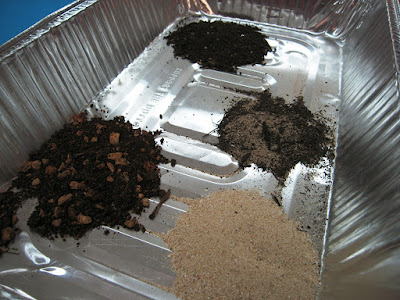We'll see about that.
Thursday ending up being our longest day. The day started at 7 AM. Two of the students, Bree, and I appeared on the Harry Blalock Island Issues radio program to talk about our camp. We were on the show for about 20 minutes and Harry grilled the two students, Sami and Zoe, about the things they have learned this week. He also helped us record environmental public service announcments after our interview.
Harry was so impressed by the girls and the other campers that he wrote about them on his blog and on his weekly radio commentary, Food For Thought:
Then I also wanted to spend a little time talking about a group of bright young students Angelo Villagomez and Bree Reynolds brought in to my studio Thursday morning. They are part of the Beautify CNMI Marianas Challenge Summer Camp, being put on by Angelo and Bree. These students really are learning about our environment, and what they can do to help protect it. I made sure they've learned something by grilling them with questions on Island Issues. Sami and Zoe totally impressed me with what they've learned and their passion about it. The only thing that caused me any concern at all was that Sami was just way too relaxed and good on the radio. I'm afraid she could replace me in a heartbeat if she wanted to, my only consolation is that she's just going in to the 9th grade this coming year, so my job is probably safe for a couple years anyway.
Part of what they did in this camp was to write public service announcements from what they have learned to air on the radio stations. Some of them even wrote an original song about beautifying the CNMI, they wrote the words and music. They came in with their ukelele and recorded the song in my production studio. I've got to say, I absolutely love it! You'll be hearing a lot of that song and those psa's in the coming months on both of our radio stations. What a talented group of students, and something tells me these are our leaders of tomorrow. If you'd like to see some of the pictures from their summer camp, and learn what it was all about, you can go to the www.greencnmi.blogspot.com website and read all about it. Tasi Tours deserves a big thank you for donating a van and driver to help transport the campers all week to their various places. And after hearing from the students on the air, Ed Salas of Tan Holdings Corporation called up donating Shirleys lunch for all the campers that day. They had talked about how the camp was being run on a shoestring budget and they were just making do with whatever they had, so Ed called up on behalf of Tan Holdings to give them a break from peanut butter or bologna for lunch. Many thanks go out to all the various people in the community who chip in to make amazing events like this happen. And while you could technically say this was job related for Angelo, Bree is a science teacher at Hopwood Junior High School, and is supposed to be on summer vacation right now. But she loves what she's doing so much, and loves the students so much, that she donated her time to help put on this summer camp.
I think I can forgive him for calling the Micronesia Challenge the Marianas Challenge.
After several hours at the radio station we returned to Hopwood to finish up work on the coral reef models and the wastewater science projects, which led right into lunch provided by Shirley's Coffee Shop and Tan Holdings. We also worked out some of the logistics for Friday's field trips to American Memorial Park and Managaha.
After lunch we had about 30 minutes before we left for our afternoon field trip, so Bree had the students play a couple of games based on communicable diseases.
In the first game they were given a series of clues and a map of a city suffering from disease outbreaks. Using the clues, they had to determine what disease people were contracting, how the disease was being spread (water borne, etc.), and the source of the disease (the water pump on Broad Street, etc.).
Then Tasi Tours picked us up at 1:30 and took us to the CUC Waste Water Treatment plant in Sadog Tasi...or as I like to call it, Wave Jungle II.
 Our tour of the facility started in the lab. Heidi showed the students the lab and showed them how they check for bacteria in the water.
Our tour of the facility started in the lab. Heidi showed the students the lab and showed them how they check for bacteria in the water. We also asked Heidi to talk about becoming a lab chemist for a career. She told the students that they had to be good at Math.
We also asked Heidi to talk about becoming a lab chemist for a career. She told the students that they had to be good at Math. After letting use a microscope and showing us the different ways that CUC tests the effluent water, Heidi took us to the Brown Jacuzzi.
After letting use a microscope and showing us the different ways that CUC tests the effluent water, Heidi took us to the Brown Jacuzzi. Ew. This is where CUC "cleans" the water. Using a process that I would only screw up if I tried to explain, CUC gets rid of all the solids and then dump the remaining liquids into the lagoon. Yum!
Ew. This is where CUC "cleans" the water. Using a process that I would only screw up if I tried to explain, CUC gets rid of all the solids and then dump the remaining liquids into the lagoon. Yum! While we were contemplating joining the "Swim Club," some other CUC employees joined us. This led to one of the best moments of the camp.
While we were contemplating joining the "Swim Club," some other CUC employees joined us. This led to one of the best moments of the camp.Heidi asked one of the guys if there was anything he wanted to tell the kids. Without hesitation he responded, "well, kids, please don't flush your underwear down the toilet. You wouldn't believe the kinds of things we find: Shoes, underwear, even cellphones."
I'm probably going to repeat that story for the next five years.
Mylene wrote about Day 4 on her blog, Mylene Rocks.
I've got pictures and stories from Friday and Saturday morning, but I haven't uploaded the pictures yet. Come back tomorrow for an update. If the post isn't up by tomorrow, just keep waiting.































